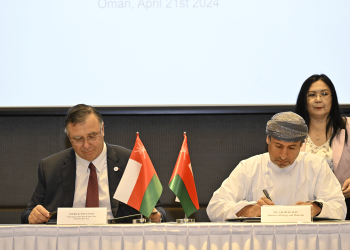The Omani government is projecting the port of Duqm as the future business hub of the country
The Omani government is projecting the port of Duqm as the future business hub of the country, even though Salalah is already up and running, and still expanding.
The last thing the Middle East needs at present is another transshipment container terminal, yet that is what it is about to get in the new Omani port of Duqm. However, the port is also intended to double up as a gateway into Oman’s rich oilfields, so it will be dual purpose, and not just specialise in container traffic. Without quite defining it this way, the Omani Government clearly wants to achieve the necessary economies of scale for Duqm through such diversification.
For example, technical and logistical challenges are said to have made it increasingly difficult for heavy project cargoes to be shipped via Sohar and Salalah, so Duqm’s port and inland infrastructure is being strengthened accordingly. Such diversification will also make it much easier for the port to establish a Special Economic Zone (SEZ), similar to that available in Dubai, than outside a container terminal specializing in transshipment traffic.
Plans for the development of a major Liquid Terminal at the Port of Duqm, designed to cater to the needs of a world-scale oil refinery as well as a future hydrocarbon-based industry in the Special Economic Zone (SEZ), are due to be kicked off shortly.
The development of petrochemical production, instead of just crude oil production, partly explains why the Middle East is seen as a promising growth area for container carriers. Two major factors come into play here for service providers:
- Rising demand for containerized cargo
- Rising transshipment cargo due to close proximity to the Asia-Europe shipping route
Major ports such as Dubai (Jebel Ali), Jeddah, Salalah and Khor Fakkan, have already been quick to capitalize to the region’s growth in container traffic. Interestingly around half of its container traffic is handled at the UAE’s two main ports, Dubai and Khor Fakkan. Half of the Dubai’s container is gateway cargo while more than 95% of the containers handled at Khor Fakkan consists of transshipment cargo.
Duqm’s operations were naturally launched softly in March 2013, therefore. A 50:50 joint venture between Consortium Antwerp Port (CAP) and the Port of Duqm Company SAOC was set up in 2010 to develop the new maritime gateway via a 28-year concession. The first phase of its container handling facility will have a 1,600m quay with 18m draught alongside, and have a handling capacity of 3.5 million teu per annum.
The Omani Government sees Duqm as a major business center of the region, with the potential to also act as an alternate business hub to Dubai. Needless-to-say, there are divergent views on its likely success.
The major advantage of Duqm is its location, being situated well outside of the Strait of Hormuz, a geo-political choke point due to escalating differences with Iran over the development of nuclear weapons. Iran has been constantly threatening to close the Strait of Hormuz in retaliation, which has raised the risk profile of voyage and insurance costs. Therefore, it is generally believed that, if given a better alternative, shippers/shipping lines will take it.

(Major container ports of the region
Source: Drewry Maritime Research)
Source: Drewry Maritime Research





























































